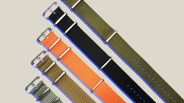NATO straps are fun. They’re inexpensive. And they’re an easy way to add some color and uniqueness to a watch. Military in origin, they’re also wildly popular despite some quirky features that are not at all practical for civilian use. NATOs are such a hit, however, that many people never question one key element of their design: an extra length of strap that folds under the watch.
A one-piece strap that simply passes under the spring bars and over the body of the watch would seem to work just fine, but NATOs have yet another layer of material that sits between watch and wrist. It’s typically folded at the buckle and sewn to the strap’s underside with a keeper on its end through which the main strap must be threaded.
If you ask a watch enthusiast what this extra fabric is for, they’ll enthusiastically tell you that if a spring bar fails during strenuous military use, the watch won’t simply fall off your wrist — as would occur with something like the standard two-piece strap. However, this doesn’t explain the NATO strap’s design at all: a single-pass strap (one without the extra length in question) would do the same job just as well.
 Photo by Hunter D. Kelley
Photo by Hunter D. KelleyNot only does this part of the NATO strap design seem unnecessary, but it creates further bulk by causing the strap to sit higher on the wrist — so much so that if you want to make a small watch wear more prominently, a NATO strap serves as a good solution. Designed to possibly be worn over a sleeve (which would be eccentric for modern casual wearers), yet more bulk is created by the necessity of tucking the strap’s end back in. There better be a good reason for all the extra fuss associated with NATO straps!
It would seem that not many people have a definitive explanation for the extra keeper. It’s been suggested that quartermasters used to hang watches on pegs by the buckle end and that this keeper would prevent the watch heads from sliding off. That doesn’t seem like a compelling enough reason for the design, but it does hint at the idea that this can keep the watch head from sliding off the strap.
In the end, it’s the NATO’s overkill and over-design that many watch wearers enjoy anyway.

